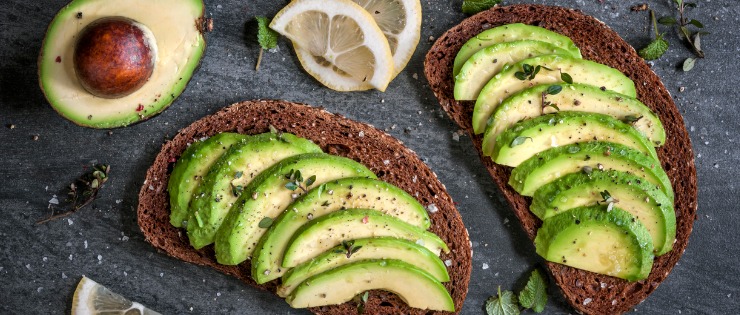
Amines make some people sick. But quite often they don’t know the cause. People think they're eating a healthy diet, but even some fruits and vegetables contain amines in high levels. There’s also the problem of the same food with varying levels of amines and the cumulative effect of amines in the human body. If you'd like to find out if you're at risk and how you can avoid consuming high levels of amines read our blog below.
What Are Amines?
Amines in food are chemicals that occur naturally, caused by bacteria that breaks down amino acids. They are related to the inorganic compound ammonia. Higher levels of amines are found in fermented, charred, grilled, over ripe, over cooked or decomposing foods. Enzymes found in the human gut, liver and intestine are responsible for breaking down amines. In most people, amines are quickly broken down and cause no problems. However, if your enzymes aren’t functioning properly, amines can build up in the body which can cause allergic symptoms or intolerances in some people. Some medications including antibiotics, older types of antidepressants, herbal and nutritional supplements can deplete enzymes.
Are Amines Toxic?
Amines are harmless for most people, however when consumed in excess or by people sensitive to amines, they can cause a range of symptoms. Amines can cause an increase in cardiac output and constriction of blood vessels in the head which can cause migraines.
Symptoms of Amine Sensitivity
The symptoms of amine sensitivity can be difficult to link to amine consumption. It can take people months or even years to recognise amines are causing them problems because:
- Amine sensitivity symptoms can take up to 48 hours to appear after consuming food.
- Amine levels accumulate in the body gradually over time
- The level of amines can differ from one portion of the same food to the next.
- Awareness of amines and the symptoms of intolerance is poor.
A person may think they have an intolerance to a food but the next time they try it, they don’t experience the same problem so they assume that food is safe. What they don’t realise is the foods they consumed prior were low in amines so their body tolerated the food with high amine levels.
People often look for one single food as the cause of their symptoms rather than the range of foods they ate within a two day period. Amine levels can be high in foods that people consider healthy and safe like fruit and vegetables so they don’t consider them as a potential source of amines.
Behavioural Problems in Children
For many years, conflicting data made it difficult to make conclusive links between children’s behaviour and their diet. In the late 1990s, 423 children who had presented to a NSW Hospital Allergy Unit were sent a questionnaire about their child’s symptoms and diet modifications. Of the 77% who started an elimination diet, 91% reported improved symptoms. The most common chemicals respondents reacted to were amines, salicylates, colours, glutamates and preservatives respectively. Parents reported significant improvements in behaviour when these were removed from their child’s diet.
Amines and Migraines
Amines in food have been linked to migraines. Around 60%-80% of the immune system is in the gut. When a sensitive person eats a food or chemical, the immune system releases mediators such as cytokines, leukotrienes, or prostaglandins they know which cause a host of chronic inflammatory conditions, including migraines.

The most common foods that can cause migraines include canned soup, processed meats, chocolate, olives, onions, overripe avocados, tomatoes and bananas, soy sauce, smoked and pickled foods.
Experts recommend elimination diets to find the food/s responsible for triggering migraines however it is difficult because symptoms can be delayed and foods have a cumulative effect. We recommend consulting with your doctor rather than just testing your own elimination diet.
Irritable Bowel Syndrome (IBS)
Another chronic inflammatory condition, IBS, has been linked to food chemical sensitivity. IBS symptoms include diarrhoea, bloating, abdominal pain and constipation.

The bacteria in the large bowel ferments undigested nutrients from food but IBS symptoms can occur when food chemicals are present. Management of IBS has focused on fermentable carbohydrates, a group of dietary sugars known as FODMAP (Fermentable Oligo-saccharides, Disaccharides, Mono-saccharides and Polyols).
Following a low FODMAP diet for 6-8 weeks can identify if this food group may be the problem. Again, consult your GP before trying any specialised diets.
Eczema and Skin Issues
For many eczema sufferers, diet can contribute to their painful skin condition but it’s difficult to know which foods cause the problem.
With eczema, foods that aren’t usually a problem, can make an eczema flare-up worse. It seems the immune system has already been triggered during an eczema attack and so many foods can cause the condition to worsen. The reaction time to eczematous food can be multiple days making it difficult to isolate problems foods. Most times, once the eczema is under control, people can reintroduce the foods with no problems.
Amines Link to Depression and Schizophrenia
There are five biogenic amine neurotransmitters (brain chemicals) - dopamine, norepinephrine (noradrenaline), epinephrine (adrenaline), histamine and serotonin.
When an imbalance of these neurotransmitters occurs such as a lack of dopamine and serotonin, nerve impulses or messages aren’t effectively transmitted in the brain.
Dopamine
Dopamine is a chemical messenger in the brain that signal other nerve cells. Dopamine is involved in reward, motivation, memory and attention and is blamed for addiction. As well as emotional responses, dopamine controls body movement so it is important for both physical and mental wellbeing.
They have used dopamine to treat Parkinson’s disease, Huntington’s disease, and depression, anxiety disorders, schizophrenia, obsessive-compulsive disorder, and attention deficit hyperactivity disorder (ADHD).
Serotonin
Similar to dopamine, serotonin is a chemical and neurotransmitter that impacts mood, anxiety and happiness. Large amounts of serotonin are released in people using recreational drugs and may damage the nerves that contain serotonin. Produced in the brain and intestines, serotonin can’t cross the blood-brain barrier. The brain must produce any serotonin used in the brain.
The body produces more serotonin after eating something that is toxic or irritating. The increased level of serotonin causes the food to move through the body faster and be expelled in diarrhea.
Schizophrenia is an illness where people experience episodes of delusions and hallucinations. Genetics, substance abuse and trauma, particularly in childhood, can cause schizophrenia. Schizophrenia starts in the late teens to early 30s.
In the last few years there has been research conducted into the role of amino acids and biogenic amines as a potential cause of schizophrenia. One study found people with psychotic symptoms had higher levels of some amino acids and biogenic amines and lower levels of others compared to the control group with no schizophrenic symptoms. Research is continuing.
The Relationship Between Histamine and Amines
Histamines are both produced by the body and consumed in foods.
Histamine helps with communicating messages in the brain, triggering the release of stomach acids for digestion and following an injury or allergic reaction. Histamines can make you sneeze, itch, cough and scratch. An overreaction in the body is the cause of allergic reactions that we use antihistamines to relieve.

Are Amines and Histamines the same thing?
Histamine is one type of biogenic amine that occurs in many foods. When we consume food that contains histamine, our gut uses its special enzymes to destroy the histamine before it’s absorbed into the bloodstream. The enzyme, Diamine Oxidase (DAO), is released into the gastrointestinal tract as the first line of defence against histamine exposure.
Histamine intolerance occurs when there isn’t enough of these enzymes in the body. The average human can cope with 50 to 100 mg/kg but people with a histamine intolerance react to much lower levels. The reactions can vary from anaphylaxis to mild localised allergic reactions. Around 80% of people with histamine intolerances are women. Estrogen and histamine can increase histamine levels and vice versa.
Histamine sensitivity is difficult to diagnose because a food can cause symptoms one day and no symptoms another. Common symptoms include heachaches, migraines, nasal congestion, hives, fatigue, nausea and vomiting. Some drugs including opioids, muscle relaxants, and alcohol cause a histamine release from immune cells.
Fish is a risky food for high histamine levels and scombroid poisoning. It occurs when the fish is not kept cold so biogenic amines form. Fresh, canned or smoked fish may be effected particularly if it is a dark meat fish such as tuna, kahawai, mackerel, bonito, kingfish, WA salmon, sardines or blue marlin. Heating or re-cooling can’t destroy amines once they have formed.
Symptoms of scombroid poisoning include rash, palpitations, headache, dizziness, sweating, and burning of the mouth and throat. Gastrointestinal symptoms can include stomach cramps, nausea, vomiting and diarrhea. Respiratory distress is also possible. Symptoms begin within 10 to 90 minutes after eating the fish.
Types of Amines
As well as histamine, there are other biogenic amines, including tyramine, putrescine, spermine, spermidine, and cadaverine. These compounds form during microbial fermentation of food (desired or not) or food spoilage.
We classify amines as primary, secondary or tertiary depending on the number of carbon atoms bonded to the nitrogen atom.
There are several types of amines in food. Two amines that can cause health problems are phenylethylamine and tyramine.
Phenylethylamine
Phenylethylamine (PEA) is an organic compound and trace amine that acts as a stimulant of the central nervous system in humans. PEA can cross the blood-brain barrier and is found in brains of humans and other mammals. PEA is sold as a supplement and taken to improve mood and to help with weight-loss however a significant quantity of the supplement is metabolised in the small intestine. Low and high concentrations of PEA have been linked with some psychological disorders. Someone with attention deficit hyperactivity disorder is likely to have low levels.
PEA is detected in meat as a microbial metabolism and in chocolate because of thermal processing. The amount increases as the cocoa ferments. Its presence can also be an indicator of bacterial contamination and is in algae, fungi and bacteria.
Tyramine
Tyramine occurs in the body to help regulate blood pressure and is consumed through food. It’s broken down by a different enzyme to DAO, called Monoamine Oxidase (MAO). Some antidepressants are MAO inhibitors. Accumulated tyramine can cause high blood pressure and severe headaches. People who take monoamine oxidase inhibitor medications are often recommended to follow a low-tyramine diet.
Tyramine occurs in some foods with levels varying depending on processing, storage and preparation methods. Foods high in tyramine include strong and aged cheeses, cured, smoked or processed meats, fermented foods, sauces, overripe fruit, alcohol and caffeine.
Treatment of High Amine Levels
Large doses of amines can have little impact on one person but a much smaller dose can have serious health implications. If you have a poor tolerance level to amines or take a medication that can interfere with amine levels, your doctor may recommend eating a low amine diet.
List of Foods High in Amines
There is a wide range of foods that have high or very high levels of amines that people with sensitivities to amines should avoid.

Foods that are high in amines include:
Vegetables
- Broccoli and cauliflower
- Rocket
- Tomato
Fruit
- Ripe bananas
- Papaya and pawpaw
- Fig
- Custard apple
- Mango
- Coconut milk and cream
Proteins
- Pork and turkey meat
- Frozen fish products
- Canned salmon and sardines
Nuts and Seeds
- Almond, brazil, chestnut, hazelnut, macadamia, peanuts and pistachio nuts
- Pumpkin, sesame, sunflower seeds
Oils
- Copha
- Coconut oil
- Olive oil
- Peanut oil
Foods that are very high in amines include:
Vegetables
- Avocado
- Eggplant
- Spinach
- Tomato (dried, puree, paste, sauce)
Fruit
- Berries, cherries, currants
- Citrus, grapes, kiwifruit, pineapple, passionfruit, plums
- Dried fruit
Proteins
- Aged beef
- Bacon and ham
- Chicken nuggets
- Sausages
- Canned tuna and anchovies
- Meat pies
Cereals
- Breakfast cereals with dried fruit and nuts
Condiments
- Gravy and sauces
- Fish, oyster, soy and miso sauces
- Tomato and barbeque sauce
- Tomato paste
- Curry powder
- Vinegar (except malt vinegar)
Nuts and Seeds
- Hummus
- Almond and hazelnut meal
- Peanut paste
- Roasted nuts
- Sesame and mustard seeds
- Coconut
Oils
- Packaged salad dressings
- Extra virgin, avocado, sesame oils
Drinks
- Fruit juices
- Soft drink
- Chocolate drinks
- Fruit cordials
- Vegetable juices
For more information see the Low Amine Diet produced by the South Australian Women’s and Children’s Hospital. For a list of foods high in salicylates and amines, see the list produced by the Royal Prince Alfred Hospital Allergy Unit in NSW. After years of lab testing on the chemical content of food (salicylate, amine, glutamate and food additives), the hospital is a world leading allergy unit. Levels of amines in food rise with age so only eat foods fresh and not as leftovers or after their best before date.
Seek Medical Advice First
If you are experiencing symptoms of food intolerance or allergy, consult your doctor. They can make a diagnosis of your symptom (migraine, irritable bowel, rash) before determining if diet plays a role in your symptoms.
Consult your doctor before beginning an elimination diet and make sure it’s only short-term as prolonged restricted diets can lead to nutrition problems.